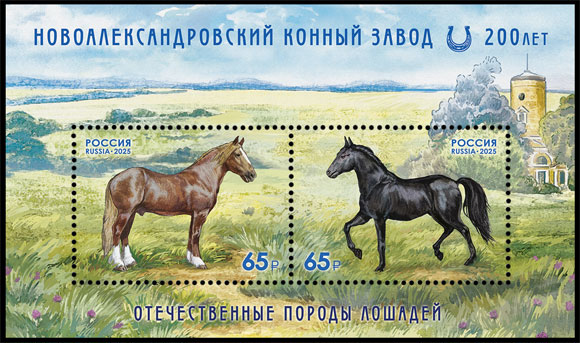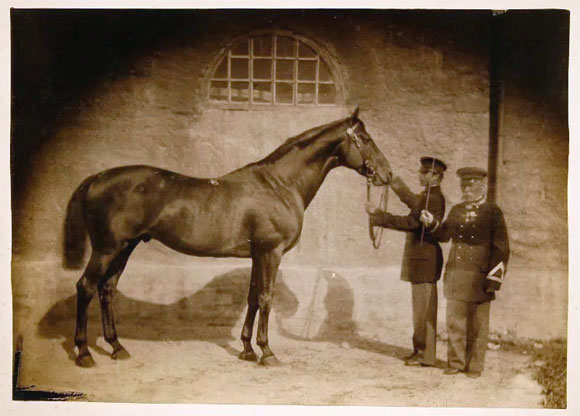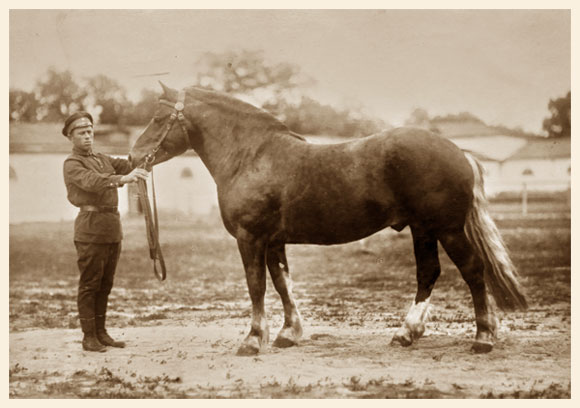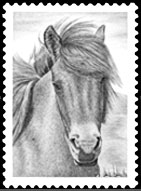
On August 8, 2025, Russian Post issued a souvenir sheet featuring domestic horse breeds in honor of the 200th anniversary of the Novoaleksandrovsky Stud Farm.
In the late 18th and early 19th centuries, four major state stud farms were established in the Belovodsk region: Derkulsky, Limarevsky, Novoaleksandrovsky, and Streletsky. The Belovodsk stud farms were under the military administration; their main purpose was to breed and supply hardy riding horses to the cavalry regiments of the Russian Imperial Army.
The decision to build a new stud farm in Belovodsk on the Yevsug River was made in 1820. The design was developed by Grigory Ivanovich Bukin, chief architect of the Stud Farm Committee of the Russian Empire, and construction began in 1822.

The main advantage of the architecture of the old Russian stud farms is that the entire complex of factory buildings was created according to a unified stylistic concept with a distinct artistic theme. The stud farm traditionally consisted of three areas: production (stables, veterinary hospitals, workshops, warehouses), administrative (farm office, apartments for the manager and veterinarian, and a riding school), and the surrounding park.
The architectural ensemble of the Novoaleksandrovsk stud farm is designed in the Russian classical style, characterized by simplicity and austerity. The key structure of the estate complex is the main stable building. Its central section, with a long pediment, is flanked by two small porticoes. Above it, a square forecourt is erected, crowned by a majestic round tower. The stable buildings extend in long wings on either side of the central entrance.
By the fall of 1823, the stud farm was already staffed with workers and employees. Around the same time, 220 horses from the Derkulsky, Streletsky, Limarevsky, and other stud farms were delivered to Novoaleksandrovka to form the horse herd. In 1825, the stud farm was officially opened under the name "Novoaleksandrovsky," named in honor of Emperor Alexander I.

By the mid-19th century, the stud farm already had over 500 horses. Through the breeding efforts of the farm's specialists, a herd of strong and hardy half-blooded horses was created. For nearly a century, the cuirassiers, lancers, hussars, and jäger regiments of the Russian army were staffed with horses bred at the Novoaleksandrovsky stud farm.

In the 1920s, the Novoaleksandrovsky stud farm underwent a change in focus: systematic work began on developing a new type of Russian heavy draft horse based on the Ardennes heavy draft horse. The breeders' long-term efforts were crowned with success. In the 1950s and 1960s, the "Novoaleksandrovsky" (Ukrainian) type of Russian heavy draft horse was developed, officially recognized by the USSR Ministry of Agriculture in 1970.
Currently, the Novoaleksandrovsky Stud Farm continues its operations. It specializes in raising and marketing two horse breeds: the Novoaleksandrovsky heavy draft horse and the Ukrainian saddle horse.

These breeds are depicted on the postage stamps in the souvenir sheet: a Novoaleksandrovsky heavy draft horse on the left, and a Ukrainian saddle horse on the right. Artist Alina Maria Saltykova depicted the horses grazing freely, and the lush green meadows continue in the margins of the sheet. On the right, the central stable building with its characteristic tower can be seen behind the treetops.
Unexpectedly, the postage stamps do not include inscriptions with the names of the horse breeds. I don't know whether this was an error during the preparation of the block for printing, or whether this design was originally planned.
Novoaleksandrovsky Heavy Draft Horse
The Novoaleksandrovsky Heavy Draft Horse is characterized by a massive yet lean build, a harmonious body structure, energy, good nature, and high work capacity and productivity. Height at the withers ranges from 148 to 155 cm. Colors include chestnut, bay, black, dun, roan, and brown. The Novoaleksandrovsky differs from the Russian Heavy Draft Horse in its smaller size, leaner legs, and neat head.
Ukrainian Saddle Horse
The Ukrainian Saddle Horse breed we know today was recognized as an independent breed in 1990. The Novoaleksandrovsky Stud Farm is one of the sites where breeding work on this breed has been and continues.
Ukrainian Saddle Horses are characterized by a strong build, tall stature, and a harmoniously developed physique. The height at the withers is 162-165 cm. The head is proportional and massive, the neck is long and set high, the withers are high, the back is straight, the chest is deep and wide, the legs are well-shaped with well-developed joints. The color is bay, black, and chestnut.
The distinctive features of the Ukrainian riding horse breed are their elegance, endurance, efficient movement at all gaits, intelligence, and quick wit. Ukrainian riding horses have gained great popularity not only due to their appearance but also due to their high athletic qualities.
The release of a souvenir sheet highlighted the significance of the Novoaleksandrivsky Stud Farm, recalling its rich history and contribution to the development of domestic horse breeding.


The souvenir sheet was issued in a limited edition of 27,000. A first-day cover, two maximum cards, and a special postmark were also included. The stamp presentation and cancellation ceremony for the 200th anniversary of the Novoaleksandrivsky Stud Farm took place in the Belovodsky District. Representatives of the LPR administration, the Ministry of Communications, and the Ministry of Agriculture participated, as did Anna Pavlovskaya, Director of the Novoaleksandrivsky Stud Farm, and the Director of the Luhansk Museum of Local History.

I would like to thank the staff of the Novoaleksandrovsky stud farm for their assistance in preparing this material.
Перейти в каталог
I apologize for any errors or inaccuracies


